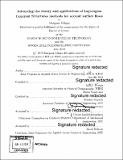| dc.contributor.advisor | Irina I. Rypina and Thomas Peacock. | en_US |
| dc.contributor.author | Filippi, Margaux(Martin-Filippi) | en_US |
| dc.contributor.other | Joint Program in Applied Ocean Science and Engineering. | en_US |
| dc.contributor.other | Massachusetts Institute of Technology. Department of Earth, Atmospheric, and Planetary Sciences. | en_US |
| dc.contributor.other | Woods Hole Oceanographic Institution. | en_US |
| dc.date.accessioned | 2019-09-26T20:59:43Z | |
| dc.date.available | 2019-09-26T20:59:43Z | |
| dc.date.copyright | 2019 | en_US |
| dc.date.issued | 2019 | en_US |
| dc.identifier.uri | https://hdl.handle.net/1721.1/122328 | |
| dc.description | Thesis: Sc. D., Joint Program in Applied Ocean Science and Engineering (Massachusetts Institute of Technology, Department of Earth, Atmospheric, and Planetary Sciences; and the Woods Hole Oceanographic Institution), 2019 | en_US |
| dc.description | Cataloged from PDF version of thesis. | en_US |
| dc.description | Includes bibliographical references (pages 207-218). | en_US |
| dc.description.abstract | Ocean surface transport is at the core of many environmental disasters, including the spread of marine plastic pollution, the Deepwater Horizon oil spill and the Fukushima nuclear contamination. Understanding and predicting flow transport, however, remains a scientific challenge, because it operates on multiple length- and time-scales that are set by the underlying dynamics. Building on the recent emergence of Lagrangian methods, this thesis investigates the present-day abilities to describe and understand the organization of flow transport at the ocean surface, including the abilities to detect the underlying key structures, the regions of stirring and regions of coherence within the flow. Over the past four years, the field of dynamical system theory has adapted several algorithms from unsupervised machine learning for the detection of Lagrangian Coherent Structures (LCS). The robustness and applicability of these tools is yet to be proven, especially for geophysical flows. | en_US |
| dc.description.abstract | An updated, parameter-free spectral clustering approach is developed and a noise-based cluster coherence metric is proposed to evaluate the resulting clusters. The method is tested against benchmarks flows of dynamical system theory: the quasi-periodic Bickley jet, the Duffing oscillator and a modified, asymmetric Duffing oscillator. The applicability of this newly developed spectral clustering method, along with several common LCS approaches, such as the Finite-Time Lyapunov Exponent, is tested in several field studies. The focus is on the ability to predict these LCS in submesoscale ocean surface flows, given all the uncertainties of the modeled and observed velocity fields, as well as the sparsity of Lagrangian data. This includes the design and execution of field experiments targeting LCS from predictive models and their subsequent Lagrangian analysis. | en_US |
| dc.description.abstract | These experiments took place in Scott Reef, an atoll system in Western Australia, and off the coast of Martha's Vineyard, Massachusetts, two case studies with tidally-driven channel flows. The FTLE and spectral clustering analyses were particularly helpful in describing key transient flow features and how they were impacted by tidal forcing and vertical velocities. This could not have been identified from the Eulerian perspective, showing the utility of the Lagrangian approach in understanding the organization of transport. | en_US |
| dc.description.statementofresponsibility | by Margaux Filippi. | en_US |
| dc.format.extent | 218 pages | en_US |
| dc.language.iso | eng | en_US |
| dc.publisher | Massachusetts Institute of Technology | en_US |
| dc.rights | MIT theses are protected by copyright. They may be viewed, downloaded, or printed from this source but further reproduction or distribution in any format is prohibited without written permission. | en_US |
| dc.rights.uri | http://dspace.mit.edu/handle/1721.1/7582 | en_US |
| dc.subject | Joint Program in Applied Ocean Science and Engineering. | en_US |
| dc.subject | Earth, Atmospheric, and Planetary Sciences. | en_US |
| dc.subject | Woods Hole Oceanographic Institution. | en_US |
| dc.subject.lcsh | Dissertations, Academic. | en_US |
| dc.subject.lcsh | Marine pollution. | en_US |
| dc.subject.lcsh | Ocean circulation. | en_US |
| dc.title | Advancing the theory and applications of Lagrangian Coherent Structures methods for oceanic surface flows | en_US |
| dc.title.alternative | Advancing the theory and applications of LCS methods for oceanic surface flows | en_US |
| dc.type | Thesis | en_US |
| dc.description.degree | Sc. D. | en_US |
| dc.contributor.department | Massachusetts Institute of Technology. Department of Earth, Atmospheric, and Planetary Sciences | en_US |
| dc.contributor.department | Woods Hole Oceanographic Institution | en_US |
| dc.contributor.department | Joint Program in Oceanography/Applied Ocean Science and Engineering | en_US |
| dc.identifier.oclc | 1119388496 | en_US |
| dc.description.collection | Sc.D. Joint Program in Applied Ocean Science and Engineering (Massachusetts Institute of Technology, Department of Earth, Atmospheric, and Planetary Sciences; and the Woods Hole Oceanographic Institution) | en_US |
| dspace.imported | 2019-09-26T20:59:37Z | en_US |
| mit.thesis.degree | Doctoral | en_US |
| mit.thesis.department | EAPS | en_US |
